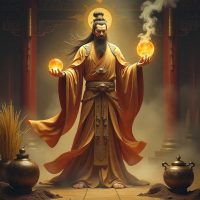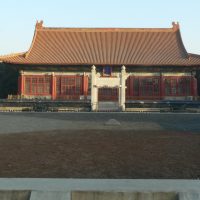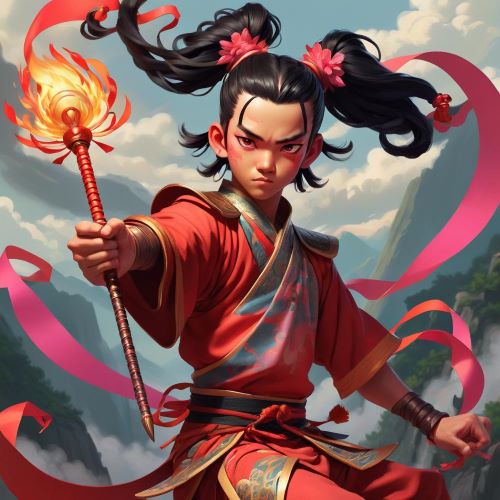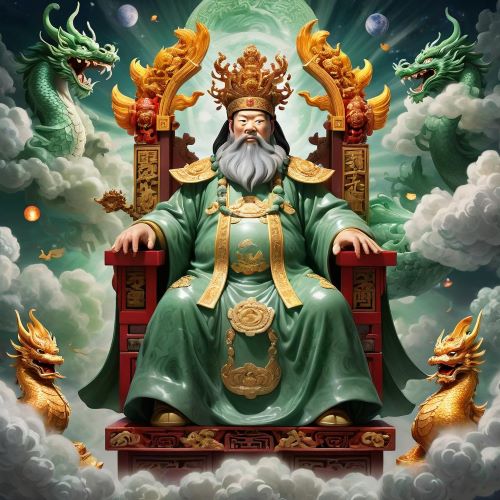Sheji : The Chinese God of Soil and Grain
Listen
At a glance
| Description | |
|---|---|
| Origin | Chinese Mythology |
| Classification | Gods |
| Family Members | N/A |
| Region | China |
| Associated With | Soil, Grain |
Sheji
Introduction
In the heart of ancient Chinese civilization, where survival depended on the rhythm of the seasons, few deities commanded as much reverence as Sheji (社稷). Representing both She, the spirit of the soil, and Ji, the spirit of grain, Sheji embodied the foundations of agrarian life. To early China, the fertility of the land was far more than a practical concern—it was the measure of cosmic harmony, political stability, and the favor of heaven itself. For this reason, Sheji was not simply a divine protector of crops but a symbol of national prosperity, a deity whose blessings could legitimize emperors and sustain entire dynasties.
Across early capitals, emperors built Altars of Sheji, sacred spaces where rituals were performed to ensure rich harvests and the stability of the realm. These ceremonies affirmed the ruler’s sacred duty to maintain balance between heaven, earth, and humanity. In many ways, understanding Sheji means understanding how deeply agriculture shaped Chinese society, philosophy, and governance.
Physical Traits
Sheji stands apart from most gods in Chinese mythology because the deity’s form is symbolic rather than anthropomorphic. Instead of appearing as a singular human-like figure, Sheji was traditionally expressed through ritual architecture, sacred mounds, and offerings of soil and grain. This abstract portrayal reflects the belief that the forces represented by Sheji—earth and food—are too fundamental and too vast to be confined to a fixed physical form.
Nonetheless, later traditions and artistic interpretations sometimes imagined Sheji in a unified human shape. When personified, Sheji is often depicted as a dignified deity blending the features of both elements: the grounding heaviness of soil and the radiant vitality of grain. Earth-toned garments, golden accents resembling ripened millet, and a calm, stabilizing presence all symbolize Sheji’s role in nurturing life.
Imperial altars also contributed to Sheji’s identity. Pentagonal altars representing the Five Elements, exposed mounds of soil open to the sky, and vessels filled with grain stood as tangible expressions of the deity. Whether depicted as a god or represented through natural materials, Sheji always aligned closely with the land itself—unpredictable, essential, and life-giving.
Family
Unlike deities who belong to large mythological families, Sheji arises not from a divine lineage but from cosmic necessity. The forces embodied by Sheji—soil and grain—are elemental rather than genealogical, originating from the natural world itself rather than from parental gods. Because of this, Sheji’s “family” is understood through thematic association rather than literal ancestry, forming a conceptual network of deities connected through the shared responsibility of sustaining life and ensuring prosperity.
Among the figures most closely linked to Sheji is Hou Tu, the revered Earth Goddess who governs the land and its stability. Her nurturing presence makes her a symbolic counterpart to Sheji’s soil aspect. Another influential figure is Hou Ji, the legendary Lord of Millet, celebrated for teaching early communities the essential practices of cultivation. His contributions to agricultural knowledge align naturally with the grain aspect of Sheji, placing him in close spiritual proximity to the deity.
Although neither Hou Tu nor Hou Ji are depicted as Sheji’s parents or children, their functions intertwine with Sheji’s domain, and they frequently appear together in ritual contexts. Beyond these divine counterparts, the emperor himself played a crucial role in Sheji’s ritual “family.” As the intermediary between heaven, earth, and the people, the emperor was responsible for performing the sacred offerings at the altars of Sheji, reinforcing the belief that political legitimacy depended on honoring the forces that sustained the nation.
In this way, Sheji’s family becomes more symbolic than personal—a constellation of earth-related deities and human rulers linked by their collective duty to protect the land, nurture agriculture, and secure the wellbeing of society.
Other names
Throughout China’s long history, Sheji has been known by a variety of names and titles, each reflecting a different aspect of the deity’s significance. One of the earliest romanizations, She Chi, appears frequently in classical literature and preserves the traditional pronunciation of 社稷. In many historical records, Sheji is also referred to as the State Altars, a title that underscores the deity’s role as a guardian of national stability and a symbol of the state’s very foundation. Early legends even assign individual names to the two components of Sheji, with the soil deity sometimes called Gou Long, while the grain spirit could be known as Zhu or Qi, depending on the region and period.
Sheji’s influence extended beyond China and into the wider Sinosphere, where the deity’s concept was adapted into local cultural and political systems. In Vietnam, Sheji is known as Xã Tắc, representing the same link between land, grain, and national order. In Korea, the deity appears as Sajik, incorporated into traditional state rituals that honored earth and harvest spirits. Japan also adopted the idea through the term Shashoku, which preserved the concept of venerating soil and grain as pillars of state wellbeing.
Even though these names differ across languages and eras, the essence of Sheji remains constant: the deity embodies the land that nourishes the people and the harvest that ensures the survival and stability of the nation.
Powers and Abilities
The powers of Sheji are grounded in the fundamental forces that determine whether a society flourishes or falters. As the deity of soil and grain, Sheji governs the earth’s capacity to sustain life, ensuring that the land remains fertile and responsive to the rhythms of the seasons. This influence over soil richness and agricultural vitality made Sheji indispensable to communities that relied entirely on the land for survival. Equally significant is the deity’s control over the abundance of grain. Sheji oversees the growth of crops from the moment seeds enter the earth until the harvest is gathered, making the deity central to food security in a world where famine could threaten entire populations.
Beyond nurturing fertility and abundance, Sheji also protects agriculture from the many natural forces capable of destroying it. Farmers believed the deity could shield their fields from droughts, floods, pests, and other calamities that might wipe out a year’s work in a matter of days. This protective role extended into the political sphere as well, where Sheji symbolized the stability of the state itself. In ancient China, times of turmoil were often described as “endangering the altars of Sheji,” a phrase that suggested the very foundation of the nation was at risk. Without productive land and a reliable harvest, no ruler could claim legitimacy or maintain authority.
At a deeper level, Sheji’s power was also understood as a force of cosmic balance. Ritual offerings to the deity were believed to maintain harmony between humanity and the natural world, aligning human activity with the will of heaven—a central principle in Chinese cosmology. Through this combination of nurturing, protection, and cosmic alignment, Sheji stood not merely as an agricultural spirit but as a guardian of civilization itself.
Modern Day Influence
Although large-scale state rituals dedicated to Sheji faded with the end of imperial rule, the deity’s legacy continues to shape Chinese culture in subtle but enduring ways. The word “Sheji” itself remains a powerful term, used today to refer to the deepest interests of the nation—the land, the people, and the foundation of society. Historic Sheji altars, such as the iconic one in Beijing, are preserved as cultural heritage sites that continue to teach modern visitors about ancient state rituals.
In rural festivals, echoes of Sheji’s worship persist through celebrations honoring earth, grain, and seasonal transitions. These customs, though not always explicitly tied to the deity, reflect the continuing respect for agriculture that Sheji once personified.
In academic study, Sheji frequently appears in discussions of governance, ritual, and early religious development. The deity also plays an important role in comparative mythology across East Asia, illustrating how agrarian societies elevate the land and its bounty into sacred symbols of national identity.
In essence, Sheji lives on not through temples or worshippers but through cultural memory—the understanding that the relationship between people and the land is sacred, timeless, and central to human survival.
Related Images
Source
The Editors of Encyclopaedia Britannica. (1998). Sheji. Encyclopaedia Britannica. https://www.britannica.com/topic/Sheji
Chinaknowledge.de. (2018). Sheji 社稷, the state altars of soil and grain. https://www.chinaknowledge.de/History/Terms/sheji.html
Wikipedia contributors. (2025, March 5). Shiji Niangniang. Wikipedia. https://en.wikipedia.org/wiki/Shiji_Niangniang
Lu, L. (2024). Appearance Politics. Oxford Academic. https://academic.oup.com/cornell-scholarship-online/book/60139/book-pdf/63248858/upso-9781501777851.pdf
Boloji.com article: The World of Fables and Legends. (2025, May 3). The World of Fables and Legends – 17. https://www.boloji.com/articles/52967/the-world-of-fables-and-legends–17
Delft University of Technology. (n.d.). In the Name of Conservation. https://pure.tudelft.nl/ws/portalfiles/portal/142459867/9789463666503_WEB.pdf
Wikipedia contributors. (2016, July 20). Chinese gods and immortals. Wikipedia. https://en.wikipedia.org/wiki/Chinese_gods_and_immortals
Frequently Asked Questions
Who is Sheji in Chinese mythology?
Sheji is the combined deity of soil and grain, representing the agricultural foundations of the Chinese state.
Why did emperors worship Sheji?
Emperors performed sacrifices to Sheji to secure fertile land, abundant harvests, and legitimacy to rule.
What does Sheji look like?
Sheji is usually symbolized through soil and grain altars, though later art sometimes shows the deity as a single divine figure blending earth and harvest motifs.
Is Sheji worshipped today?
Formal worship has declined, but Sheji survives in cultural rituals, idioms, and preserved state altars across China.
What does the term “Sheji” mean in modern Chinese?
It refers to the fundamental interests of the nation, symbolizing the land, its people, and the stability of the state.










